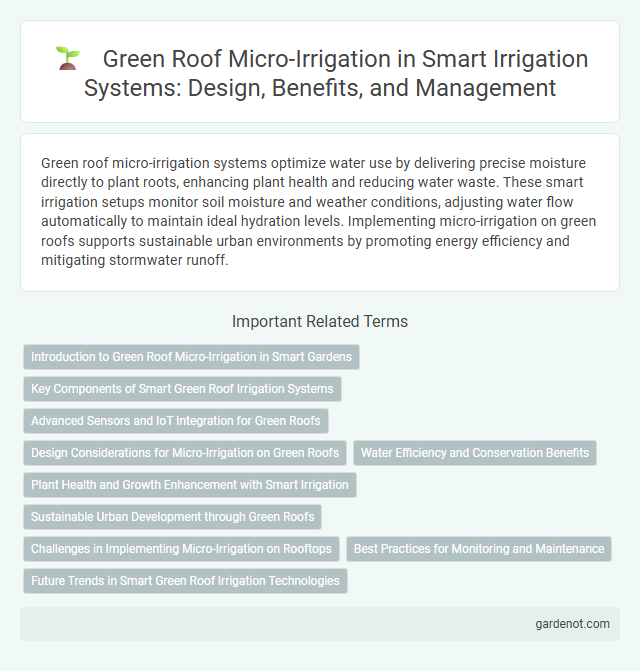Green roof micro-irrigation systems optimize water use by delivering precise moisture directly to plant roots, enhancing plant health and reducing water waste. These smart irrigation setups monitor soil moisture and weather conditions, adjusting water flow automatically to maintain ideal hydration levels. Implementing micro-irrigation on green roofs supports sustainable urban environments by promoting energy efficiency and mitigating stormwater runoff.
Introduction to Green Roof Micro-Irrigation in Smart Gardens
Green roof micro-irrigation systems optimize water use by delivering precise moisture directly to plant roots, enhancing plant health while reducing water waste. These systems integrate advanced sensors and automated controls to adapt irrigation schedules based on real-time weather conditions and soil moisture levels. Utilizing drip emitters and capillary mats, green roof micro-irrigation supports sustainable urban gardening by minimizing runoff and improving water retention in smart garden environments.
Key Components of Smart Green Roof Irrigation Systems
Smart green roof irrigation systems rely on components like moisture sensors, automated valves, and weather-based controllers to optimize water use. These systems integrate soil moisture probes that monitor substrate hydration levels, triggering drip emitters to maintain ideal plant health. Incorporating real-time climate data ensures efficient water distribution, reducing waste and supporting sustainable rooftop ecosystems.
Advanced Sensors and IoT Integration for Green Roofs
Advanced sensors integrated with IoT technology optimize green roof micro-irrigation by continuously monitoring soil moisture, temperature, and humidity levels to deliver precise water amounts. Real-time data analytics enable automated adjustments, reducing water waste and promoting healthy plant growth in urban environments. This smart irrigation approach enhances sustainability by conserving water resources and improving rooftop vegetation resilience.
Design Considerations for Micro-Irrigation on Green Roofs
Design considerations for micro-irrigation on green roofs include selecting efficient emitters to manage limited water availability and prevent runoff. Soil composition, root depth, and plant species must be analyzed to optimize water distribution and retention. Incorporating pressure compensating drippers and automated scheduling systems enhances uniform irrigation, ensuring sustainable water use and plant health.
Water Efficiency and Conservation Benefits
Green roof micro-irrigation systems significantly enhance water efficiency by delivering precise amounts of water directly to plant roots, minimizing evaporation and runoff. These systems utilize advanced sensors and drip emitters to optimize water usage, reducing overall consumption by up to 40% compared to traditional irrigation methods. The conservation benefits include sustaining urban greenery during droughts and lowering stormwater runoff, which helps mitigate flooding and improves water quality in surrounding environments.
Plant Health and Growth Enhancement with Smart Irrigation
Green roof micro-irrigation systems optimize water delivery to vegetation, promoting consistent soil moisture levels crucial for plant health and robust growth. These smart irrigation technologies use sensors to monitor microclimate conditions, enabling precise watering that reduces water waste and prevents root diseases caused by overwatering. Enhanced hydration management on green roofs supports stronger root development and increased plant vitality, contributing to improved urban environmental benefits.
Sustainable Urban Development through Green Roofs
Green roof micro-irrigation systems enhance sustainable urban development by optimizing water use efficiency and promoting vegetation health on green roofs. These systems deliver precise amounts of water directly to plant roots, reducing runoff and conserving resources in densely populated areas. Integrating smart irrigation technology with green roofs supports climate resilience, urban heat island mitigation, and improved air quality.
Challenges in Implementing Micro-Irrigation on Rooftops
Implementing micro-irrigation systems on green roofs faces challenges such as limited water pressure, ensuring uniform water distribution, and adapting to varying rooftop substrates. The complexity of rooftop environments requires precise calibration to avoid water runoff and system clogging caused by debris or sediment. Maintenance accessibility and structural load limitations further complicate the integration of efficient micro-irrigation networks in urban green roof projects.
Best Practices for Monitoring and Maintenance
Green roof micro-irrigation systems require precise monitoring of soil moisture levels using sensor technology to optimize water usage and promote plant health. Regular inspection of emitters and tubing ensures consistent water distribution, preventing blockages and leaks that could impair system efficiency. Integrating automated scheduling based on weather data enhances maintenance by adjusting irrigation timing, reducing water waste and supporting sustainable green roof ecosystems.
Future Trends in Smart Green Roof Irrigation Technologies
Emerging smart green roof micro-irrigation systems leverage IoT sensors and AI algorithms to optimize water usage by dynamically adjusting irrigation schedules based on real-time soil moisture, weather forecasts, and plant health data. Integration of renewable energy sources and advanced materials for water retention enhances sustainability and efficiency in urban environments. Future trends prioritize predictive analytics and autonomous irrigation networks to significantly reduce water waste and promote resilient green infrastructures.
Green roof micro-irrigation Infographic

 gardenot.com
gardenot.com